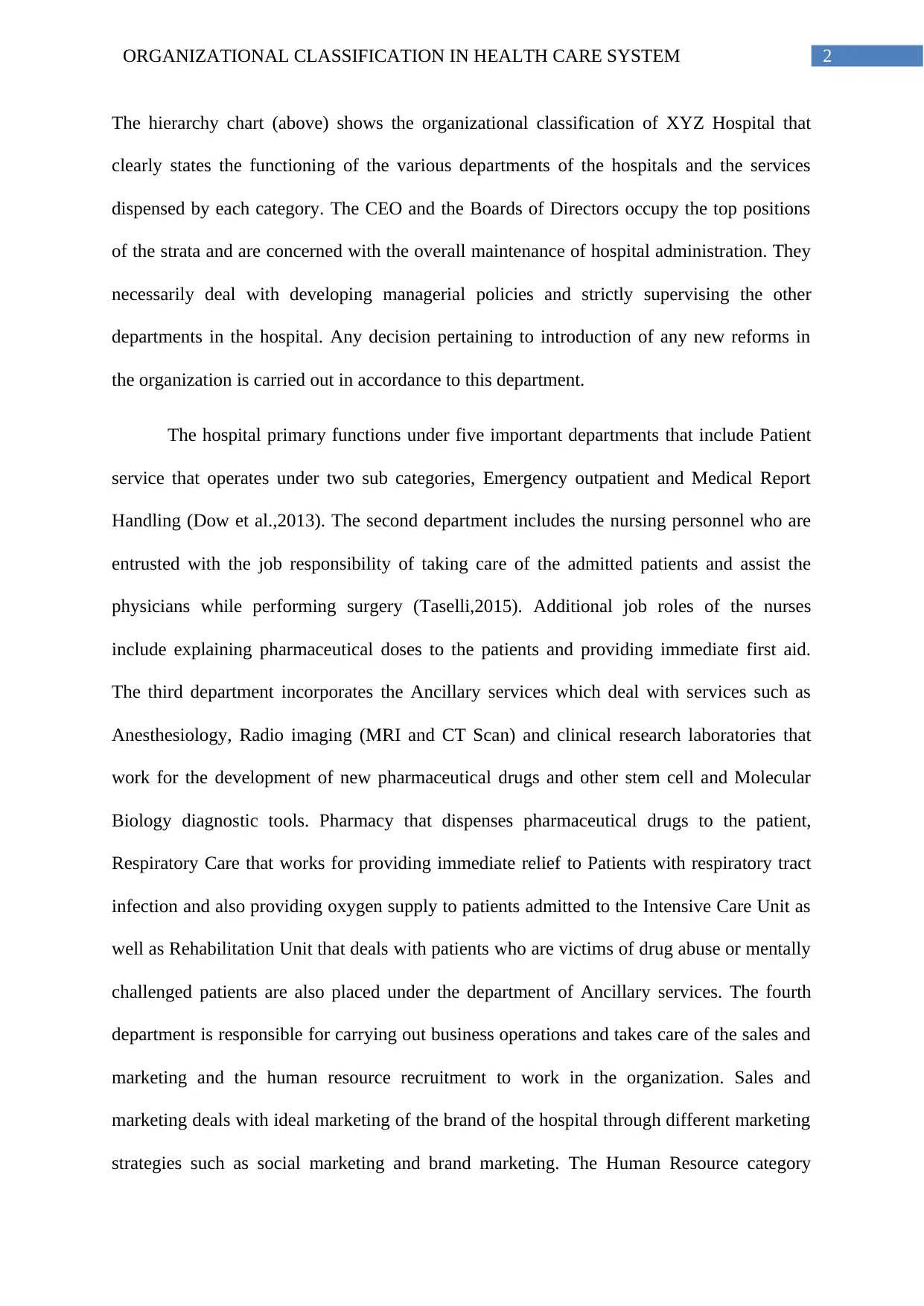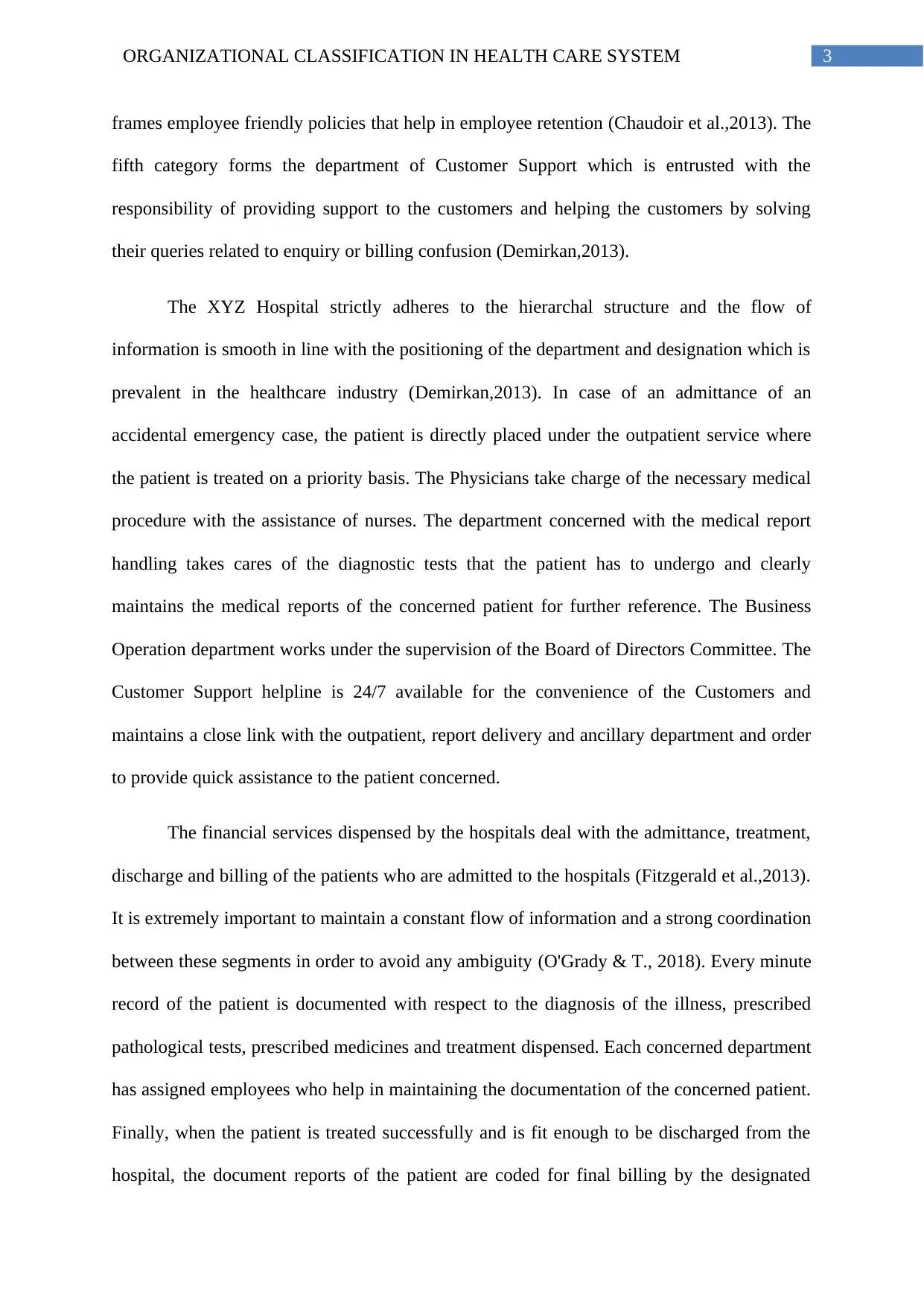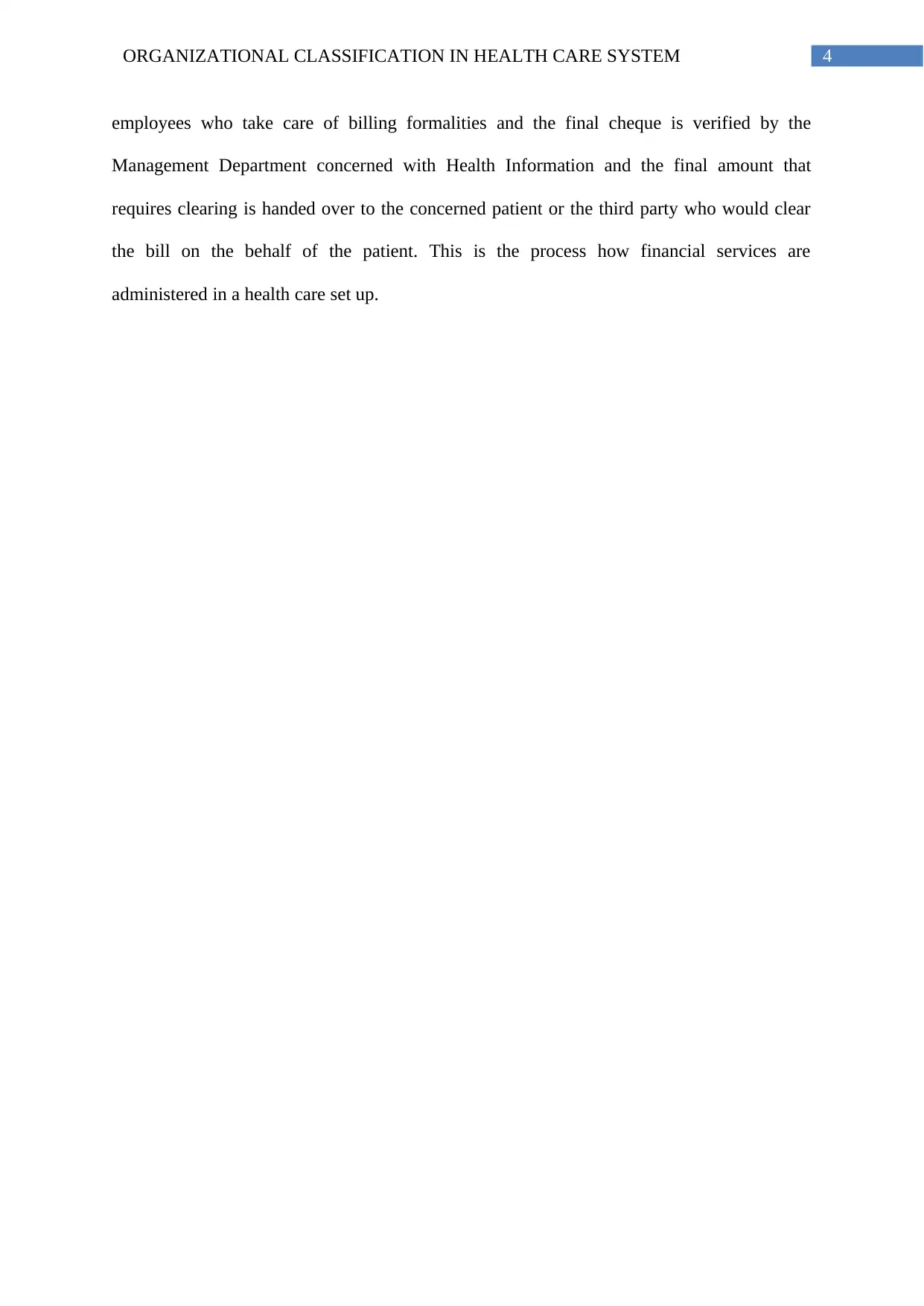Organizational Classification in Health Care System
VerifiedAdded on 2023/06/10
|6
|1136
|434
AI Summary
This article discusses the organizational classification of XYZ Hospital and the functioning of various departments in the healthcare system. It also highlights the importance of maintaining a constant flow of information and coordination between different segments to avoid ambiguity.
Contribute Materials
Your contribution can guide someone’s learning journey. Share your
documents today.

Running head: ORGANIZATIONAL CLASSIFICATION IN HEALTH CARE SYSTEM
Name of the Student:
Name of the University:
Author Note:
Name of the Student:
Name of the University:
Author Note:
Secure Best Marks with AI Grader
Need help grading? Try our AI Grader for instant feedback on your assignments.

1ORGANIZATIONAL CLASSIFICATION IN HEALTH CARE SYSTEM
HOSPITAL CEO
PHARMACY
REHABILITA
TION UNIT
RESPIRATOR
Y CARE
ANESTHESIO
LOGY
CLINIC
LABORATOR
IES
RADIO
IMAGING
EMERGENCY
OUTPATIENT
MEDICAL
REPORT
HANDLING
BOARD OF DIRECTORS
NURSING STAFF ANCILLARY
SERVICEPATIENT SERVICE BUSINESS
OPERATION
CUSTOMER
SUPPORT
GENERAL
SUPPORT
SERVICE
HUMAN
RESOURCES
SALES AND
MARKETING
Organizational Classification Chart:
Source as created by Author
HOSPITAL CEO
PHARMACY
REHABILITA
TION UNIT
RESPIRATOR
Y CARE
ANESTHESIO
LOGY
CLINIC
LABORATOR
IES
RADIO
IMAGING
EMERGENCY
OUTPATIENT
MEDICAL
REPORT
HANDLING
BOARD OF DIRECTORS
NURSING STAFF ANCILLARY
SERVICEPATIENT SERVICE BUSINESS
OPERATION
CUSTOMER
SUPPORT
GENERAL
SUPPORT
SERVICE
HUMAN
RESOURCES
SALES AND
MARKETING
Organizational Classification Chart:
Source as created by Author

2ORGANIZATIONAL CLASSIFICATION IN HEALTH CARE SYSTEM
The hierarchy chart (above) shows the organizational classification of XYZ Hospital that
clearly states the functioning of the various departments of the hospitals and the services
dispensed by each category. The CEO and the Boards of Directors occupy the top positions
of the strata and are concerned with the overall maintenance of hospital administration. They
necessarily deal with developing managerial policies and strictly supervising the other
departments in the hospital. Any decision pertaining to introduction of any new reforms in
the organization is carried out in accordance to this department.
The hospital primary functions under five important departments that include Patient
service that operates under two sub categories, Emergency outpatient and Medical Report
Handling (Dow et al.,2013). The second department includes the nursing personnel who are
entrusted with the job responsibility of taking care of the admitted patients and assist the
physicians while performing surgery (Taselli,2015). Additional job roles of the nurses
include explaining pharmaceutical doses to the patients and providing immediate first aid.
The third department incorporates the Ancillary services which deal with services such as
Anesthesiology, Radio imaging (MRI and CT Scan) and clinical research laboratories that
work for the development of new pharmaceutical drugs and other stem cell and Molecular
Biology diagnostic tools. Pharmacy that dispenses pharmaceutical drugs to the patient,
Respiratory Care that works for providing immediate relief to Patients with respiratory tract
infection and also providing oxygen supply to patients admitted to the Intensive Care Unit as
well as Rehabilitation Unit that deals with patients who are victims of drug abuse or mentally
challenged patients are also placed under the department of Ancillary services. The fourth
department is responsible for carrying out business operations and takes care of the sales and
marketing and the human resource recruitment to work in the organization. Sales and
marketing deals with ideal marketing of the brand of the hospital through different marketing
strategies such as social marketing and brand marketing. The Human Resource category
The hierarchy chart (above) shows the organizational classification of XYZ Hospital that
clearly states the functioning of the various departments of the hospitals and the services
dispensed by each category. The CEO and the Boards of Directors occupy the top positions
of the strata and are concerned with the overall maintenance of hospital administration. They
necessarily deal with developing managerial policies and strictly supervising the other
departments in the hospital. Any decision pertaining to introduction of any new reforms in
the organization is carried out in accordance to this department.
The hospital primary functions under five important departments that include Patient
service that operates under two sub categories, Emergency outpatient and Medical Report
Handling (Dow et al.,2013). The second department includes the nursing personnel who are
entrusted with the job responsibility of taking care of the admitted patients and assist the
physicians while performing surgery (Taselli,2015). Additional job roles of the nurses
include explaining pharmaceutical doses to the patients and providing immediate first aid.
The third department incorporates the Ancillary services which deal with services such as
Anesthesiology, Radio imaging (MRI and CT Scan) and clinical research laboratories that
work for the development of new pharmaceutical drugs and other stem cell and Molecular
Biology diagnostic tools. Pharmacy that dispenses pharmaceutical drugs to the patient,
Respiratory Care that works for providing immediate relief to Patients with respiratory tract
infection and also providing oxygen supply to patients admitted to the Intensive Care Unit as
well as Rehabilitation Unit that deals with patients who are victims of drug abuse or mentally
challenged patients are also placed under the department of Ancillary services. The fourth
department is responsible for carrying out business operations and takes care of the sales and
marketing and the human resource recruitment to work in the organization. Sales and
marketing deals with ideal marketing of the brand of the hospital through different marketing
strategies such as social marketing and brand marketing. The Human Resource category

3ORGANIZATIONAL CLASSIFICATION IN HEALTH CARE SYSTEM
frames employee friendly policies that help in employee retention (Chaudoir et al.,2013). The
fifth category forms the department of Customer Support which is entrusted with the
responsibility of providing support to the customers and helping the customers by solving
their queries related to enquiry or billing confusion (Demirkan,2013).
The XYZ Hospital strictly adheres to the hierarchal structure and the flow of
information is smooth in line with the positioning of the department and designation which is
prevalent in the healthcare industry (Demirkan,2013). In case of an admittance of an
accidental emergency case, the patient is directly placed under the outpatient service where
the patient is treated on a priority basis. The Physicians take charge of the necessary medical
procedure with the assistance of nurses. The department concerned with the medical report
handling takes cares of the diagnostic tests that the patient has to undergo and clearly
maintains the medical reports of the concerned patient for further reference. The Business
Operation department works under the supervision of the Board of Directors Committee. The
Customer Support helpline is 24/7 available for the convenience of the Customers and
maintains a close link with the outpatient, report delivery and ancillary department and order
to provide quick assistance to the patient concerned.
The financial services dispensed by the hospitals deal with the admittance, treatment,
discharge and billing of the patients who are admitted to the hospitals (Fitzgerald et al.,2013).
It is extremely important to maintain a constant flow of information and a strong coordination
between these segments in order to avoid any ambiguity (O'Grady & T., 2018). Every minute
record of the patient is documented with respect to the diagnosis of the illness, prescribed
pathological tests, prescribed medicines and treatment dispensed. Each concerned department
has assigned employees who help in maintaining the documentation of the concerned patient.
Finally, when the patient is treated successfully and is fit enough to be discharged from the
hospital, the document reports of the patient are coded for final billing by the designated
frames employee friendly policies that help in employee retention (Chaudoir et al.,2013). The
fifth category forms the department of Customer Support which is entrusted with the
responsibility of providing support to the customers and helping the customers by solving
their queries related to enquiry or billing confusion (Demirkan,2013).
The XYZ Hospital strictly adheres to the hierarchal structure and the flow of
information is smooth in line with the positioning of the department and designation which is
prevalent in the healthcare industry (Demirkan,2013). In case of an admittance of an
accidental emergency case, the patient is directly placed under the outpatient service where
the patient is treated on a priority basis. The Physicians take charge of the necessary medical
procedure with the assistance of nurses. The department concerned with the medical report
handling takes cares of the diagnostic tests that the patient has to undergo and clearly
maintains the medical reports of the concerned patient for further reference. The Business
Operation department works under the supervision of the Board of Directors Committee. The
Customer Support helpline is 24/7 available for the convenience of the Customers and
maintains a close link with the outpatient, report delivery and ancillary department and order
to provide quick assistance to the patient concerned.
The financial services dispensed by the hospitals deal with the admittance, treatment,
discharge and billing of the patients who are admitted to the hospitals (Fitzgerald et al.,2013).
It is extremely important to maintain a constant flow of information and a strong coordination
between these segments in order to avoid any ambiguity (O'Grady & T., 2018). Every minute
record of the patient is documented with respect to the diagnosis of the illness, prescribed
pathological tests, prescribed medicines and treatment dispensed. Each concerned department
has assigned employees who help in maintaining the documentation of the concerned patient.
Finally, when the patient is treated successfully and is fit enough to be discharged from the
hospital, the document reports of the patient are coded for final billing by the designated
Secure Best Marks with AI Grader
Need help grading? Try our AI Grader for instant feedback on your assignments.

4ORGANIZATIONAL CLASSIFICATION IN HEALTH CARE SYSTEM
employees who take care of billing formalities and the final cheque is verified by the
Management Department concerned with Health Information and the final amount that
requires clearing is handed over to the concerned patient or the third party who would clear
the bill on the behalf of the patient. This is the process how financial services are
administered in a health care set up.
employees who take care of billing formalities and the final cheque is verified by the
Management Department concerned with Health Information and the final amount that
requires clearing is handed over to the concerned patient or the third party who would clear
the bill on the behalf of the patient. This is the process how financial services are
administered in a health care set up.

5ORGANIZATIONAL CLASSIFICATION IN HEALTH CARE SYSTEM
References:
Chaudoir, S. R., Dugan, A. G., & Barr, C. H. (2013). Measuring factors affecting
implementation of health innovations: a systematic review of structural,
organizational, provider, patient, and innovation level measures. Implementation
Science, 8(1), 22.
Demirkan, H. (2013). A smart healthcare systems framework. It Professional, 15(5), 38-45.
Dow, A. W., DiazGranados, D., Mazmanian, P. E., & Retchin, S. M. (2013). Applying
organizational science to health care: A framework for collaborative practice.
Academic medicine: journal of the Association of American Medical Colleges, 88(7),
952.
Fitzgerald, L., Ferlie, E., McGivern, G., & Buchanan, D. (2013). Distributed leadership
patterns and service improvement: Evidence and argument from English healthcare.
The Leadership Quarterly, 24(1), 227-239.
O'Grady, P., & T., M. (2018). Innovation Leadership and Professional Governance: Building
the Structure for Transformation (5th ed., pp. 114-116). Burlington: MA: Jones &
Bartlett Learning.
Tasselli, S. (2015). Social networks and inter-professional knowledge transfer: the case of
healthcare professionals. Organization Studies, 36(7), 841-872.
References:
Chaudoir, S. R., Dugan, A. G., & Barr, C. H. (2013). Measuring factors affecting
implementation of health innovations: a systematic review of structural,
organizational, provider, patient, and innovation level measures. Implementation
Science, 8(1), 22.
Demirkan, H. (2013). A smart healthcare systems framework. It Professional, 15(5), 38-45.
Dow, A. W., DiazGranados, D., Mazmanian, P. E., & Retchin, S. M. (2013). Applying
organizational science to health care: A framework for collaborative practice.
Academic medicine: journal of the Association of American Medical Colleges, 88(7),
952.
Fitzgerald, L., Ferlie, E., McGivern, G., & Buchanan, D. (2013). Distributed leadership
patterns and service improvement: Evidence and argument from English healthcare.
The Leadership Quarterly, 24(1), 227-239.
O'Grady, P., & T., M. (2018). Innovation Leadership and Professional Governance: Building
the Structure for Transformation (5th ed., pp. 114-116). Burlington: MA: Jones &
Bartlett Learning.
Tasselli, S. (2015). Social networks and inter-professional knowledge transfer: the case of
healthcare professionals. Organization Studies, 36(7), 841-872.
1 out of 6
Your All-in-One AI-Powered Toolkit for Academic Success.
+13062052269
info@desklib.com
Available 24*7 on WhatsApp / Email
![[object Object]](/_next/static/media/star-bottom.7253800d.svg)
Unlock your academic potential
© 2024 | Zucol Services PVT LTD | All rights reserved.